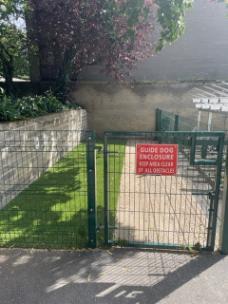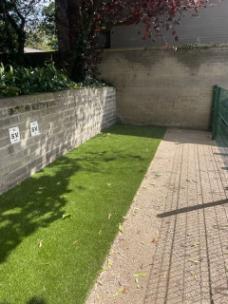Section 38 of the Act enables any person by themselves, or through any person defined under Section 9 (2) of the Act, to make a complaint in writing to the UCD Inquiry Officer in relation to the failure of the University to comply with sections 25, 26, 27, 28 or 29 of the Act. More information on making Complaints under the Disability Act 2005 here.
Information about Campus Accessibility
UCD’s ambition is to be a University for All, where everyone is welcome. Our objective is to provide an inclusive university, by engaging with all our users. The Disability Act 2005 sets out the legal requirements for public sector bodies to be accessible to everyone. The Act requires that a Campus Accessibility Officer oversees and liaises with the University's personnel to provide accessible goods and services for everyone's use. Tina Lowe is UCD’s Campus Accessibility Officer. Contact (opens in a new window)campusaccessibility@ucd.ie if you have any requests or wish to bring to the attention any issues in relation to access the campus.
What is a (opens in a new window)Guide dog?
A guide dog is a working dog trained to assist blind and partially sighted people.
When a guide dog is born the puppy is brought to the guide dog centre and the guide dog trainers begin looking at the litter to see what traits each puppy has.
The puppies are then raised by puppy walkers who take each puppy from the age of 8 weeks to live with them and be socialized.
Each puppy learns social skills, toilet training, how to stop at steps, how to navigate the outdoor environment and walk on a lead and how to interact in public spaces including transport and shopping centres, and any other public amenities. The various public amenities teach the puppy in training about noises, smells, crowds of people, other dogs, children and how to negotiate different settings.
The puppy is then brought to the guide dog centre at the age of 14 months where they will begin their training.
The training includes the early training unit and advanced training, and then the puppy is chosen for guide dog training if the guide dog trainer has assessed and passed the puppy on each stage of training.
The guide dog in training then learns how to guide and the guide dog trainer then matches the guide dog to a blind person. The matching process involves assessing where the blind person lives, where they work or study, if they live in a built up area, if they live in a quiet area, how fast they walk, and how many routes they may do so it is a very intricate and complicated process.
The matched partnership of the guide dog and blind person commences by travelling to the centre to begin working with the guide dog. This training involves learning route training, learning to give commands to the guide dog, learning dog psychology, hygiene and grooming of the guide dog, feeding and dietary requirements, training in the centre and then in the person’s home and work environment.
The guide dog is a working dog so it must follow strict rules which include not being fed by members of the public, being groomed, being checked regularly by the vet, and working routes that both the guide dog and owner have learned.
The guide dog must use the guide dog enclosure or toilet area in UCD as part of the training (see guide dog enclosure area).
The guide dog must not be approached by the public when working.
Always ask the owner if it is ok to say hello to the guide dog, however when the guide dog and owner are working please do not disturb the partnership as the guide dog has been trained to work a specific route, and for safety and concentration on behalf of both the guide dog owner and guide dog it is best not to approach or interrupt the working partnership.
Guide Dog Enclosure Area on Campus
A guide dog enclosure is a toilet area located to the left of the entrance at the James Joyce Library building.
This area is solely for the purpose of enabling your guide dog to relieve themselves.

Each guide dog owner is responsible for picking up and disposing of their guide dogs’ excrement.
There is a gate which must remain closed and shut after each guide dog owner and their guide dog has used the area.
There is a sign which clearly states that this area is only for guide dog owners use.
The area is divided into two sections, one has fake grass for the guide dogs to relieve themselves on and the other side is a paved area with accessible paving for the guide dog owner to stand on while their guide dog is using the facility.

General Tips
- When you meet a blind person make sure to introduce yourself and ask if the person would like any assistance.
- Always speak directly to the blind person when guiding them.
- If the blind person states that they would like help, ask how they like to be guided. Normally the options are by taking your elbow or resting their hand on your shoulder
How to guide a blind person around a building
- Inform them where they are in the building
- When approaching a door, place the person’s hand on the door handle and allow them to pull the door to them so they know where the door is in the room
- Inform the person when you are approaching a step, and always state if it is up or downwards
- When you enter into a space, such as an office, inform the person about the layout of the space, and then guide them to a seat
- Place their hand on the back of the seat so that they can then sit into it independently
- If you are giving the person a cup or glass place it in their hand
- Always remember to let the person know if you are leaving the room
How to guide a blind person outside
- Give your elbow or shoulder to the blind person to guide them
- When guiding a person, remember to inform them when you are approaching steps or kerbs, and tell whether they go up or down. Inform them about any obstacles on the route - an example could be, “We are now approaching some steps up, there is a railing on your left. We are at the top now and we will walk straight ahead”.
- If you have to walk through a narrow space inform the blind person and ask them to tuck in behind your elbow so that you walk in a single file until the narrow part of the route widens out again
- Don’t forget to say goodbye. Don’t walk away from the blind person without saying you are leaving or moving away
What is an Induction Loop Sound System?
A Changing place is a stand-alone toilet facility that provides specific equipment to accommodate adults with disabilities toilet requirements. The space normally includes: a hoist, an adult sized changing table, regulation sized waste disposal bin and waste paper dispenser, a private screen, a height adjustable toilet seat and washbasin.
There are 2 changing places/toilet facilities on the Belfield campus. These are located in:
- The Newman Arts building on the ground floor
- and in the Gerard Manly Hopkins main restaurant building on the ground floor.
NaviLens is a free application that uses colourful QR codes to assist users in finding key services and locations around the UCD campus.
Offering audio-cues, written text and vibrations to indicate distances and directions, NaviLens helps users to independently navigate the world around them. This is particularly important for internal spaces that cannot be easily captured by tools such as Google Maps.
NaviLens tags contain key information on how the service can support students, opening hours for student services, ways to get in touch, and helpful information links. NaviLens works in the language of the user's phone and offers various accessibility features meaning everyone can get key information in a way that best suits their needs.
Visit the NaviLens page for more information on the UCD NaviLens pilot and to start using the app.